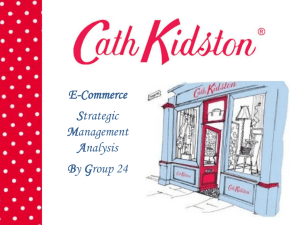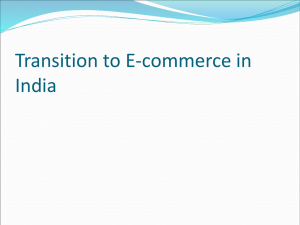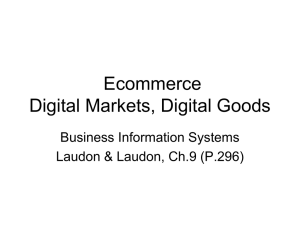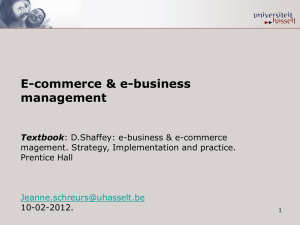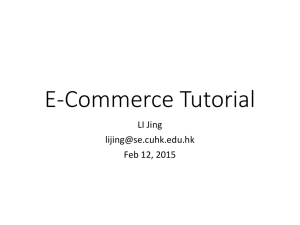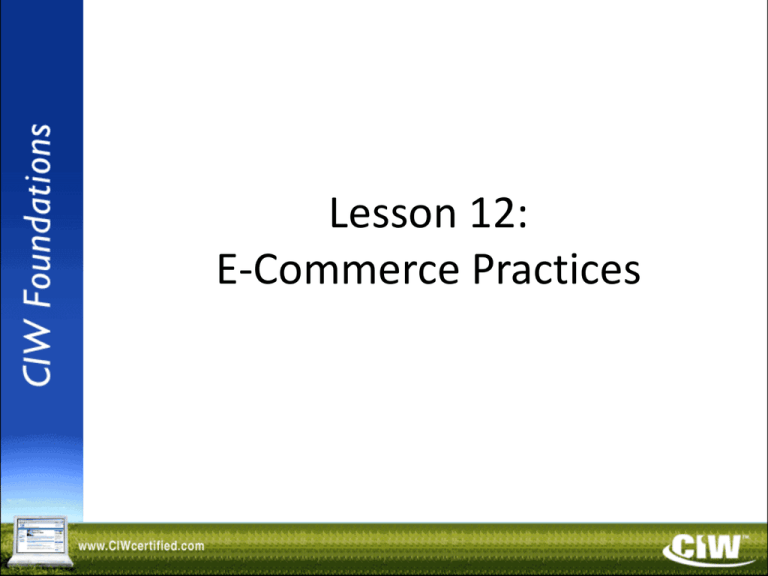
Lesson 12:
E-Commerce Practices
Copyright © 2004 ProsoftTraining, All Rights Reserved.
Lesson 12 Objectives
•
•
•
•
•
•
•
•
•
Compare e-commerce to traditional commerce
Discuss the three e-commerce models
Discuss common business operations that use Web technologies
Identify the relationship between Internet marketing and search
engine optimization (SEO)
Discuss e-commerce information-formatting technologies
Identify payment models used in e-commerce
Identify ways to protect private transactions
Identify issues related to working in a global environment
Identify ways to build e-commerce relationships using Webbased technology
Traditional Commerce
vs. E-Commerce
• Similarities
– Both aim to deliver a valued product or service
– Both want to serve a large audience
– Both strive to quickly deliver products and services
• Differences
– E-commerce customers expect shorter fulfillment time
– E-commerce customers must understand Web-based
technologies
– E-commerce provides a global audience
– E-commerce orders are processed without human interaction
or travel to a store location
– E-commerce relies upon encryption for security
E-Commerce Models
• Business to consumer (B2C)
– Targets consumers or end users, and sells
products and/or services
• Amazon.com, small business sites
• Business to business (B2B)
– Helps organizations to manage relationships and
transactions with other businesses
• B2Bxchange
• Consumer to consumer (C2C)
– Consumers buy and sell products or services to
other consumers
• eBay, Craigslist
E-Commerce Models
• Business to consumer (B2C)
– Targets consumers or end users, and sells
products and/or services
• Amazon.com, small business sites
• Business to business (B2B)
– Helps organizations to manage relationships and
transactions with other businesses
• B2Bxchange
• Consumer to consumer (C2C)
– Consumers buy and sell products or services to
other consumers
• eBay, Craigslist
Business and Internet
Technologies
• Traditional businesses also use ecommerce
– Not an either/or proposition
– Web technologies make traditional business
more efficient
• E-commerce concepts:
– Supply chain management
– Enterprise resource planning (ERP)
– B2B information sharing
Supply Chain Management (SCM)
• The ability to manage the process that
generates a product and distributes it to
customers
– You must manage the process that begins with
raw materials and ends with a product delivered
to a consumer
– Customer can be:
• An end user
• Another business that resells your product after adding
value to it, known as a Value Added Reseller (VAR)
Supply Chain Management (SCM)
(cont'd)
• Traditional supply chain management model
• Professionals running e-commerce sites
increasingly need to understand this model
Supply Chain Management (SCM)
(cont'd)
• Supply chain management involves the
following business aspects:
– Product demand
– Information flow
– Finance management
• Essential supply chain management terms
– Upstream and downstream
– Capacity requirements plan
– Additional terms found in coursebook
Enterprise Resource Planning (ERP)
• Use of software to create an automated plan
for company operations
• ERP goal – enhance communication among all
company departments and divisions through
software automation
• Accomplished through automation of tasks and
reporting
• All company/organization departments
involved
• Common terms:
– Bolt-on system
– Application programming interface (API)
– Library
B2B Information Sharing
with XML
• XML allows information to be indexed
once, then used in many different
applications and companies
• DTD limitations
• XML schema
Internet Marketing and
Search Engine Optimization (SEO)
• Marketing terms
• Internet marketing consists of:
– Search engine optimization (SEO)
– Pay per click (PPC)
– Web analytics
Search Engine Optimization (SEO)
• SEO improves the volume and quality of traffic
to a Web site by structuring content to
improve search engine ranking
• An SEO expert must:
– Learn about and consider the factors that search
engines take into account as they rank sites
– Try to create and edit Web pages accordingly
• Common SEO tactics
• Writing quality Web copy
Pay Per Click (PPC)
• PPC – list your site high in search engine
rankings by advertising on keywords that
describe your product or service
• You simply pay to have your page listed as
highly as possible
• Most Internet marketing campaigns combine
SEO and PPC strategies
Web Analytics
• Web analytic types:
– On-site analytics
• Use trend analysis software to analyze server
logs
• Tag pages
– Off-site analytics
•
•
•
•
•
Identify the size of your market
Identify competitors
Determine your market penetration
Conduct surveys
Consult market research sources
Complete Internet Marketing
• A successful marketing campaign involves:
– A competent leader
– A team effort
– Continued effort
– Follow-up
E-Commerce
Information-Formatting Technologies
• When businesses need to exchange
information, they must agree upon
universal information-formatting
methods
• The two most common ways to format
information are:
– Electronic Data Interchange (EDI)
– Open Buying on the Internet (OBI)
Electronic Data Interchange (EDI)
• A universal method for formatting information so
it can be transferred among organizations
• In place for over 20 years
• Useful for exchanging:
–
–
–
–
–
Invoices
Bills
Purchase orders
Inventory lists
Supply chain information
• EDI implementation and drawbacks
• EDI and XML
Open Buying on the Internet (OBI)
• Designed as an alternative to EDI
• Developed to target high-volume, lowcost transactions
– These account for almost 80 percent of
most companies' purchasing activities
• OBI components
• OBI transactions
• OBI and EDI
E-Commerce
Payment Technologies
• Payment technologies include:
– Electronic Funds Transfer (EFT)
– Payment gateways
– Secure Electronic Transactions (SET)
– Open Trading Protocol (OTP)
– Secure Sockets Layer (SSL) / Transport Layer
Security (TLS)
Electronic Funds Transfer (EFT)
• A generic term that describes the ability to
transfer funds using computers rather than
paper
• Also known as wire transfer
• EFT systems must ensure:
–
–
–
–
Confidentiality of payment information
Integrity of payment information
Merchant authentication
Interoperability
• Automated Clearing House (ACH)
– Governed in the United States by the National
Automated Clearing House Association
– Used in EFT
Payment Gateway
• Mediates between a merchant and a
merchant bank
• Once the merchant receives payment from a
customer, the merchant uses the payment
gateway to transmit credit card information
to the bank
• Responsibilities:
–
–
–
–
Forwarding information
Authenticating participants
Ensuring confidentiality
Ensuring data integrity
• Payment gateway companies
Secure Electronic
Transactions (SET)
• Uses digital certificates to secure financial
transactions
• Public and private keys ensure encryption,
data confidentiality and non-repudiation
• Designed to allow both simple and complex
transactions
• History of SET
• SET example
• SET vs. conventional transactions
Open Trading Protocol (OTP)
• Alternative to SET
– An open standard (RFC 2802)
– Used for both B2C and B2B
– Often used with XML
• OTP features:
– Provides trading protocol options to control the way
that the trade occurs
– Provides a record of a particular trade
– Supports real and virtual delivery of goods and
services (payment tracking)
Secure Sockets Layer (SSL) /
Transport Layer Security (TLS)
• Not transaction methods
• Used to secure transactions
• Services provided:
– Authentication
– Data confidentiality
– Data integrity
SSL/TLS and
Public Key Infrastructure (PKI)
• You need a certificate to enable host
authentication before you can begin an
SSL session
• Public Key Infrastructure (PKI)
– A collection of individuals, networks and
machines that comprise the ability to
authoritatively confirm the identity of a
person, host or organization
PKI Elements
• PKI elements include:
– Digital certificate
– Certificate authority (CA)
– Registration authority (RA)
– Certificate server
– Certification chain
Digital Certificates and X.509
• Digital certificates used in PKI conform to the ITU
X.509 standard
• X.509 describes how to format digital certificates
PKCS Standards
• Public-Key Cryptography Standards
(PKCS)
– Used to store and transport certificates
• PKCS #7
– Used to secure e-mail certificates
• PKCS #10
– Used to generate a certificate request to a
certificate authority (CA)
Certificate Life Cycle
• Certificates usually have a limited life (e.g., 1 month, 2 years, 6
years)
• Life cycle helps reduce the likelihood of fraud
• Terms include:
– Certificate policy
– Certificate Practice Statement (CPS)
– Certificate expiration
– Certificate revocation
– Certificate suspension
– Certificate renewal
– Certificate destruction
– Certificate revocation list (CRL)
– Online Certificate Status Protocol (OCSP)
Additional SSL/TLS Concepts
• The SSL/TLS handshake
• Common applications
• Beginning an SSL/TLS session
– Encryption begins after authentication
– Issues:
•
•
•
•
•
Different host name
Certificate expired
Certificate date not yet valid
Invalid certificate format
Certificate presented by the server not signed by a
recognized CA
• Incompatible encryption settings
Working in a Global Environment
• By placing your business on the Web, you expand
your audience to include anyone in the world
with a browser and Internet access
• Consider the level to which you will
accommodate potential customers from
countries outside yours
– Issues to consider include:
•
•
•
•
Currency differences
International shipping
Language concerns
Relationship management
Currency and Trade
• Each country (e.g., China) and economic block
(e.g., European Union) uses its own currency
• Businesses and organizations must be able to:
– Automatically calculate exchange rates for the day
of the transaction
– Calculate taxes and tariffs on goods
• Taxes, tariffs and trade
International Shipping
• Consider the following issues:
– Customs searches
– Costs incurred by customs
– Delays caused by customs
– All tariffs
• Legal and regulatory issues:
– A product you sell legally in one country
may be illegal in another
– A product you sell may be heavily regulated
Language Concerns
• As you develop an e-commerce site,
consider the following issues:
– The language(s) used by the target audience
– The characters necessary (e.g.,
alphanumeric, mathematical or currency
symbols)
• Character sets and languages
– Computers can use different character sets
– Unicode
Relationship Management
• Building trust
– Quality customer service
– Frequent contact
• Customer self-service
– Automatic order tracking
– Unattended choice
– Order customization
Lesson 12 Summary
Compare e-commerce to traditional commerce
Discuss the three e-commerce models
Discuss common business operations that use Web technologies
Identify the relationship between Internet marketing and search
engine optimization (SEO)
Discuss e-commerce information-formatting technologies
Identify payment models used in e-commerce
Identify ways to protect private transactions
Identify issues related to working in a global environment
Identify ways to build e-commerce relationships using Web-based
technology
Site Development Foundations
Introduction to Web Site Development
Markup Language and Site Development Essentials
XHTML Coding
Horizontal Rules and Graphical Elements
Hyperlinks
HTML Tables
Web Forms
Image Techniques
HTML Frames
GUI HTML Editors
Advanced Web Technologies
E-Commerce Practices



